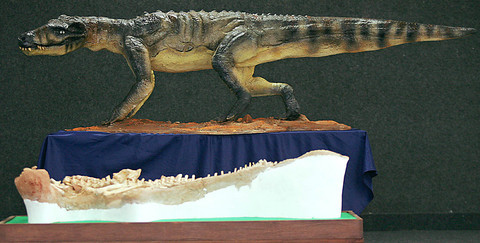Brazilian paleontologists last week proudly put on display a skeleton of a crocodile that roamed the earth in the time of the dinosaurs 90 million years ago.
The remains of the Baurusuchus salgadoensis were well preserved and included a complete head, said Pedro Henrique Nobre from the University of Rio department of geology, where the presentation was held.
"Finding a fossil is rare, but finding a collection of fossils [from the same animal] is even more rare and finding an intact head is extraordinary," Nobre said.

PHOTO: AP
The Baurusuchus was 3.5m long, and scientists estimate it weighed 400kg.
The paleontologists also presented a life-size reconstruction of what they believe the creature looked like.
The Baurusuchus remains were found 15 years ago in the western region of the state of Sao Paulo. It is the first time they have gone on display after years of restoration.
Unlike modern-day crocodiles, the Baurusuchus lived on land in a dry area. The location of the creature's nasal pasages indicated that it could not spend much time underwater, Nobre said.
The reptile had longer and more powerful rear legs than modern crocodiles, and the animal's teeth indicte that it was an active predator, he added.
The Baurusuchus belongs to the same family of ancient reptiles whose remains have been found in Argentina, southern Africa and the region between India and Pakistan. The scientists said their discovery suggests that an ancient land bridge linked South America to Indo-Pakistan.
The creature lived in the Cretaceous period, which lasted from 144 to 65 million years ago. It was the last period during which dinosaurs lived.

In Taiwan there are two economies: the shiny high tech export economy epitomized by Taiwan Semiconductor Manufacturing Co (TSMC, 台積電) and its outsized effect on global supply chains, and the domestic economy, driven by construction and powered by flows of gravel, sand and government contracts. The latter supports the former: we can have an economy without TSMC, but we can’t have one without construction. The labor shortage has heavily impacted public construction in Taiwan. For example, the first phase of the MRT Wanda Line in Taipei, originally slated for next year, has been pushed back to 2027. The government

July 22 to July 28 The Love River’s (愛河) four-decade run as the host of Kaohsiung’s annual dragon boat races came to an abrupt end in 1971 — the once pristine waterway had become too polluted. The 1970 event was infamous for the putrid stench permeating the air, exacerbated by contestants splashing water and sludge onto the shore and even the onlookers. The relocation of the festivities officially marked the “death” of the river, whose condition had rapidly deteriorated during the previous decade. The myriad factories upstream were only partly to blame; as Kaohsiung’s population boomed in the 1960s, all household

Allegations of corruption against three heavyweight politicians from the three major parties are big in the news now. On Wednesday, prosecutors indicted Hsinchu County Commissioner Yang Wen-ke (楊文科) of the Chinese Nationalist Party (KMT), a judgment is expected this week in the case involving Hsinchu Mayor Ann Kao (高虹安) of the Taiwan People’s Party (TPP) and former deputy premier and Taoyuan Mayor Cheng Wen-tsan (鄭文燦) of the Democratic Progressive Party (DPP) is being held incommunicado in prison. Unlike the other two cases, Cheng’s case has generated considerable speculation, rumors, suspicions and conspiracy theories from both the pan-blue and pan-green camps.

Stepping inside Waley Art (水谷藝術) in Taipei’s historic Wanhua District (萬華區) one leaves the motorcycle growl and air-conditioner purr of the street and enters a very different sonic realm. Speakers hiss, machines whir and objects chime from all five floors of the shophouse-turned- contemporary art gallery (including the basement). “It’s a bit of a metaphor, the stacking of gallery floors is like the layering of sounds,” observes Australian conceptual artist Samuel Beilby, whose audio installation HZ & Machinic Paragenesis occupies the ground floor of the gallery space. He’s not wrong. Put ‘em in a Box (我們把它都裝在一個盒子裡), which runs until Aug. 18, invites